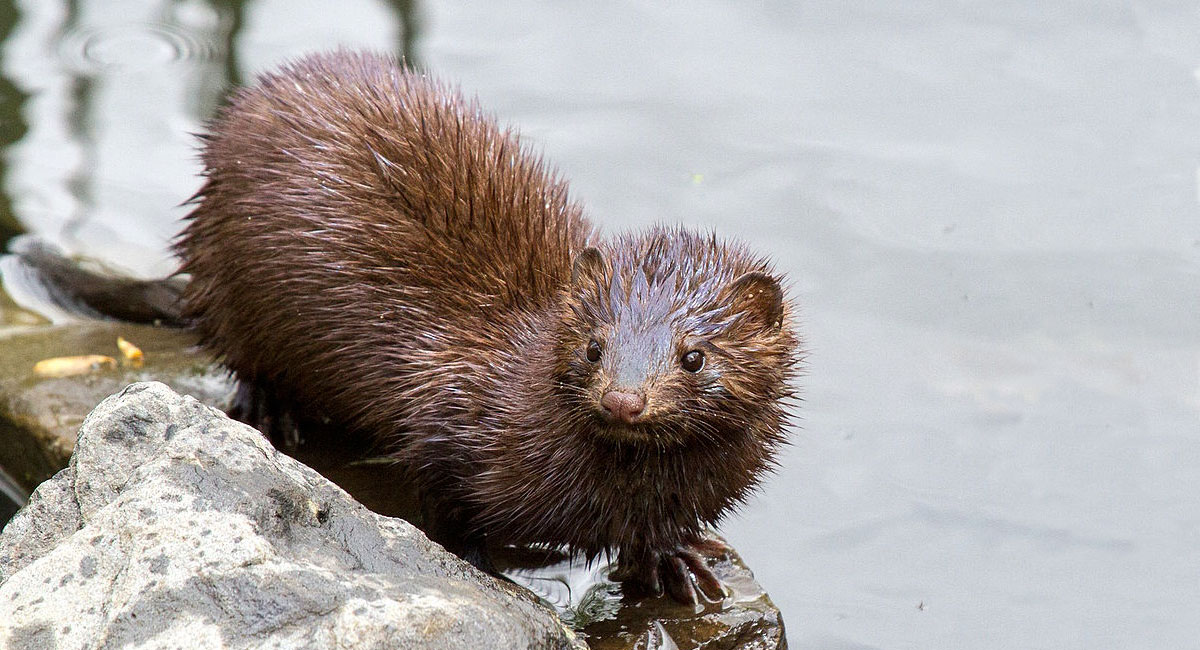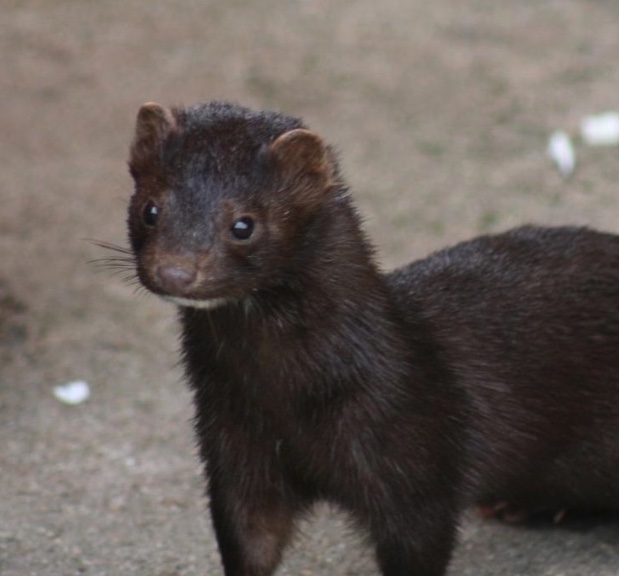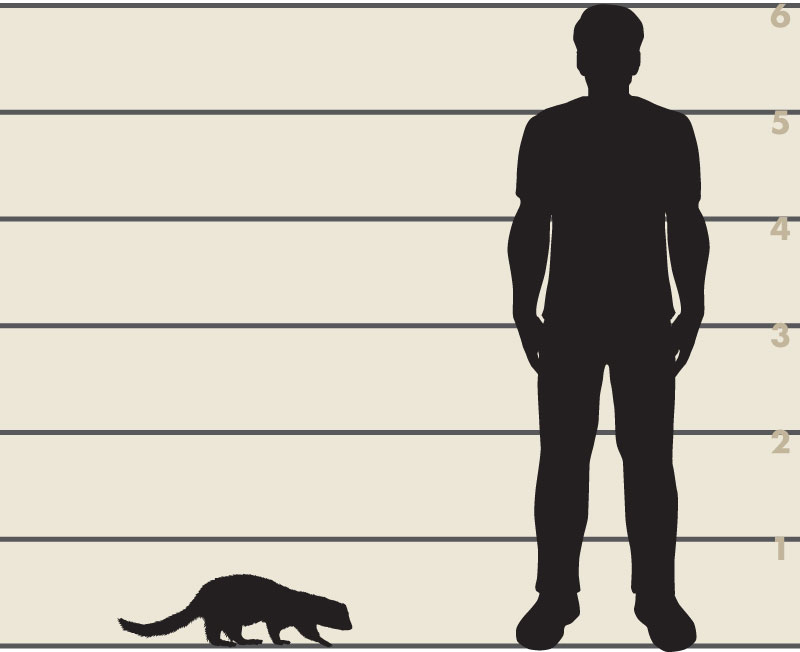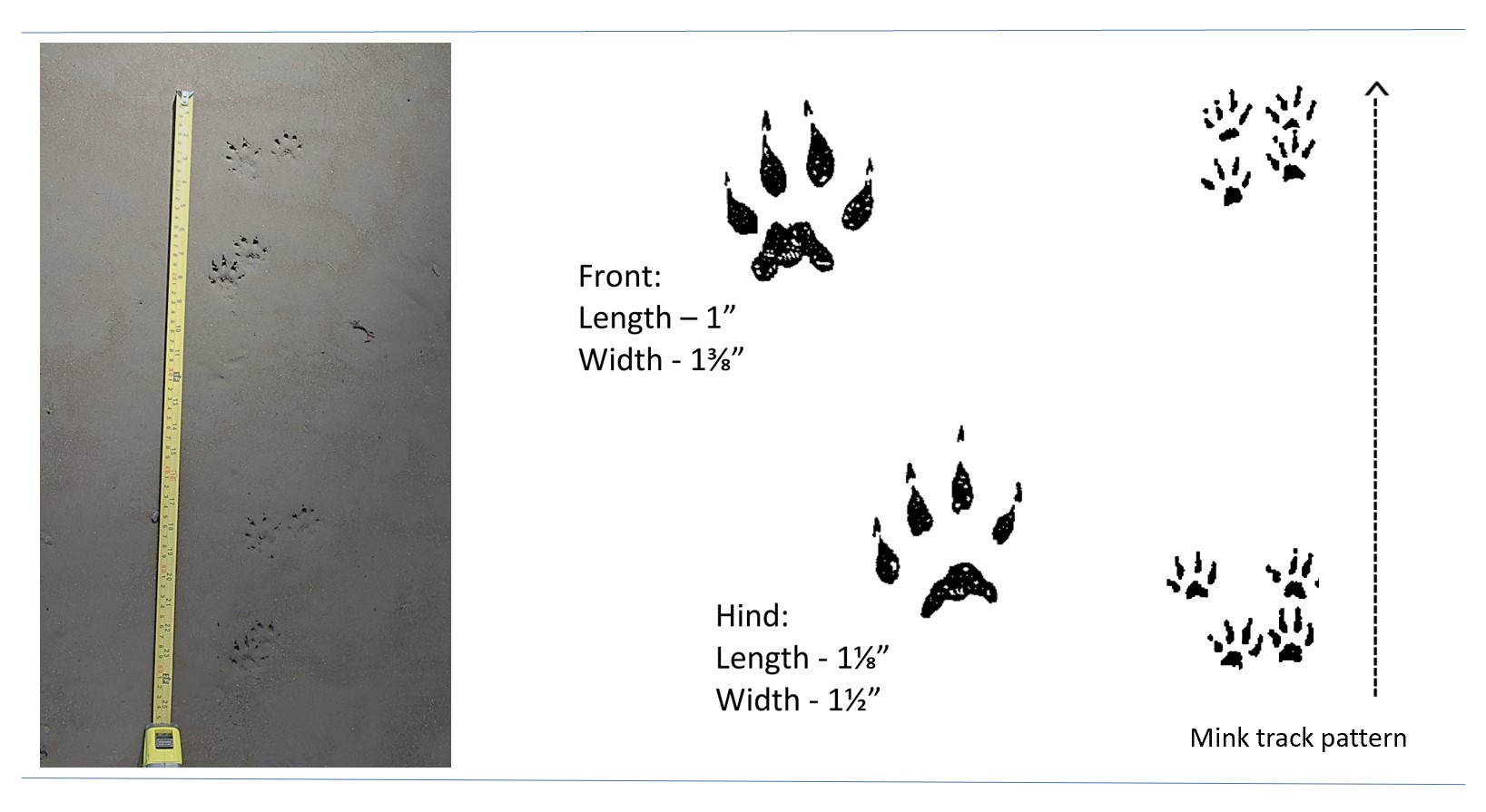
Photo: Chuck Homler, CC BY-SA 3.0
Learn more about mink in Illinois in OutdoorIllinois Journal:
Along with river otters, American minks are top predators in Illinois’ aquatic food webs. Their presence in an area indicates a functional food chain.
American minks are larger than weasels, ranging from 17¾ to 27½ inches long and weighing between 2 to 3 pounds. Males are larger than the females. Mink have long, slender bodies; small ears; and short legs. They have lustrous, dark brown to reddish fur with a white chin patch, and their tails are tipped with black fur. Irregular white patches on the throat or chest are common.
The tracks of mink are 1.3 to 2 inches long and 1.3 to 1.8 inches wide. While they have five toes on each paw, the front tracks may only show four toes and only four toes appear in the rear tracks.
Mink scat is about three inches long and resembles a braided rope. It may contain small bones, fur, feathers, crayfish parts, or fish bones. They often leave their scat on or near rocks, logs, and stumps.
American mink are found in all 102 counties in Illinois, but are most abundant in northeastern Illinois, the counties bordering the lower Mississippi River, and in the southern-third of the state. While they still are common, they are not as abundant now as they were in the past, due to habitat loss caused by development and stream channelization.
Mink are nocturnal, but they are sometimes seen during the day. During the winter, when it is very cold or when there is heavy snow cover, mink remain in their dens but they do not hibernate. Mink are solitary except when the females are raising their young.
Male mink travel more than the females, often covering an area of up to 5 square miles. Female home ranges tend to be only 20 to 50 acres. Mink tend to stay close to water. While they sometimes dig their own dens, they usually take over muskrat burrows.
Mink are quick on land, easily climb trees, and are good swimmers. For their size, mink are quite aggressive and are capable of killing much larger animals. They kill with a bite to the neck. They are known to fight with each other, especially when there are many of them in an area. They have a very strong musk that they spray from their anal glands to mark their territories.
American mink do not pose a public health threat.
Mink live on the shores of rivers, streams, lakes, ponds, and marshes. They often use burrows dug by muskrats, but are known to use cavities in brush or rock piles or in exposed tree roots. Their dens typically have 2 to 5 entrances and include a chamber about 1-foot in diameter that is lined with grass, fur, and feathers.
Mink are strict carnivores. Depending on the time of year, their diet varies. During the warmer months they mainly eat frogs, tadpoles, fish, crayfish, and muskrats. During the cooler months they eat more mammals and their diets include mice, voles, and rabbits. Large prey, such as rabbits, are often carried to the den. Mink will also eat snakes, birds, and eggs. If they figure out how to gain access to poultry, they often go back multiple times.
Mink are able to breed at 10 to 12 months of age. Mating takes place January through March, and the young are typically born in April or May. They have 1 litter per year, with 4 to 7 kits. Kits start exploring outside the den at 6 to 8 weeks of age and begin learning to hunt. Young mink are on their own by late summer.
Minks’ main predators include coyotes, foxes, bobcats, and great horned owls. They rarely live longer than 3 or 4 years in the wild.
Mink will take poultry if they can gain access to them, sometimes killing many more chickens or ducks than they can eat.
Habitat modification is typically ineffective in dealing with mink.
The best way to solve mink predation is to provide domestic animals and livestock with secure enclosures. This means the enclosures must have a roof or wire mesh top. All openings larger than 1 inch must be sealed or mink can squeeze through. One-inch mesh poultry netting should be used over ventilation openings.
Repellents and frightening devices are not effective at preventing nuisance mink issues.
Nuisance mink may be trapped if a nuisance animal permit has been issued by an Illinois Department of Natural Resources district wildlife biologist. Your local district wildlife biologist can provide options for resolving problems, including issuance of a nuisance animal removal permit.
Mink may not be hunted in Illinois, but they can be trapped from mid-November to mid-February. The Illinois Digest of Hunting and Trapping Regulations provides full trapping regulations.
The IDNR Furbearers page provides more information about hunting and trapping Furbearers. The Illinois Trapper Education Manual provides guidance on the best management practices for trapping. Trap size recommendations for mink is found on page 90; see Trapper Education Manual.
Recreational fur trapping is the preferred method to deal with nuisance furbearer issues. Trapping can help control the local population of animals and, in some cases, reduce the number of nuisance complaints and the damage that some species can cause. The Illinois Department of Natural Resources offers a lengthy trapping season (3 months, in some cases 4½ months). Legal trapping can occur 100 yards from an occupied dwelling without permission of the occupants, closer with permission as long as there are no municipal ordinances that prohibit trapping.
American mink are protected as Furbearers in Illinois. Nuisance mink may be trapped if a nuisance animal removal permit has been issued by an Illinois Department of Natural Resources District Wildlife Biologist. Mink may not be hunted in Illinois, but they can be trapped from mid-November to mid-February. There is no limit on the number of mink that can be trapped by licensed trappers. The Illinois Digest of Hunting and Trapping Regulations provides full trapping regulations.

Photo: Patrick Reijnders

Illustrator: Lynn Smith

Photo: Terry Kem and Illustrations: Dan Goodman
The Wildlife Illinois website was authorized by the Illinois Department of Natural Resources (IDNR) in partial fulfillment of project W-147-T. The website was developed by the National Great Rivers Research and Education Center, 2wav, and the IDNR in partnership with the United States Department of Agriculture Animal and Plant Health Inspection Service Wildlife Services and University of Illinois Extension to provide research-based information about how to coexist with Illinois wildlife.